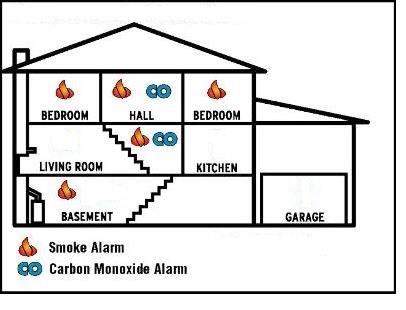Smoke Alarms and Carbon Monoxide Detectors

Remodeling your home? The state requires that you update your alarms.
- Smoke Alarms – One alarm on every level, one alarm in every bedroom, and one smoke alarm directly outside of sleeping areas.
- Carbon Monoxide (CO) Alarms – One alarm on each habitable level.
- Check manufacturer’s instructions for more detail about placement as well as maintenance and replacement. Remember that alarms expire after 10 years.

The details:
2022 CT State Building Code (Amendments to the 2021 IRC)
(Amd) R314.2.2 Alterations, repairs and additions. When alterations, repairs or additions requiring a
permit occur, or when one or more sleeping rooms are added or created in existing dwellings, the entire
dwelling unit shall be provided with smoke alarms located as required for new dwellings.
Exceptions:
1. Work involving the exterior surfaces of dwellings, such as the replacement of roofing or siding, or
the addition or replacement of windows or doors, or the addition of a porch or decks, are exempt
from the requirements of this section.
2. Installation, alteration or repairs of plumbing, mechanical or electrical systems are exempt from
the requirements of this section.
(Add) R314.2.3 During construction. Pursuant to section 29-315b of the Connecticut General Statutes,
whenever a dwelling is occupied during interior alterations or additions requiring a building permit, the
temporary installation of battery-operated smoke alarms shall be required in the vicinity of such
alterations or additions for the duration of construction activities. A combined smoke and carbon
monoxide alarm may be installed to comply with R315.2.3 and this section.
(Amd) R314.4 Interconnection. Where more than one smoke alarm is required to be installed within an
individual dwelling unit in accordance with Section R314.3, the alarm devices shall be interconnected in
such a manner that the actuation of one alarm will activate all of the alarms in the individual unit. Physical
interconnection of smoke alarms shall not be required where listed wireless alarms are installed and all
alarms sound upon activation of one alarm.
Exception: Interconnection of smoke alarms in existing areas shall not be required where
alterations or repairs do not result in removal of interior wall or ceiling finishes exposing the
structure.
(Amd) R315.2.2 Alterations, repairs and additions. Where alterations, repairs or additions requiring a
permit occur, or where one or more sleeping rooms are added or created in existing dwellings, the
individual dwelling unit shall be equipped with carbon monoxide alarms located as required for new
dwellings.
Exceptions:
1. Work involving the exterior surfaces of dwellings, such as the replacement of roofing or siding, or
the addition or replacement of windows or doors, or the addition of a porch or deck.
2. Installation, alteration or repairs of plumbing systems.
3. Installation, alteration or repairs of mechanical systems that are not fuel-fired.
(Add) R315.2.3 During construction. Pursuant to section 29-315b of the Connecticut General Statutes,
whenever a dwelling is occupied during interior alterations or additions requiring a building permit where
a fuel-burning appliance, fireplace or attached garage exists, the temporary installation of battery-operated
carbon monoxide alarms shall be required in the vicinity of such alterations or additions for the duration of
construction activities. A combined smoke and carbon monoxide alarm may be installed to comply with
Section R314.2.3 and this section.
(Amd) R315.3 Location. Carbon monoxide alarms in dwelling units shall be installed outside of each
separate sleeping area in the immediate vicinity of the bedrooms and on each additional habitable level of
the dwelling unit. Where a fuel-burning appliance is located within a bedroom or its attached bathroom, a
carbon monoxide alarm shall be installed within the bedroom. The alarm shall be clearly audible in all
bedrooms over background noise levels with all intervening doors closed.
